Orange-red variety of Hokkaido pumpkin with a nutty aroma and high content of vitamins and fiber.
All over the world, annual festivals are held in honor of this vegetable, and its composition is not inferior to the healthiest products. Pumpkin is a unique crop that is especially common among those who care about their nutrition and health.
Variety of varieties Surprisingly, each variety has unique qualities. This article will talk about a wonderful variety of Hokkaido pumpkin, which has an original appearance and exquisite taste.
Description of the Hokkaido pumpkin variety
An early ripening variety, the first harvest is obtained 3-3.5 months after planting. Vegetables are perfectly stored, which allows you to enjoy tasty and juicy pumpkins even 6-12 months after harvest. At the same time, it has a thin skin; it is often eaten along with the pulp.
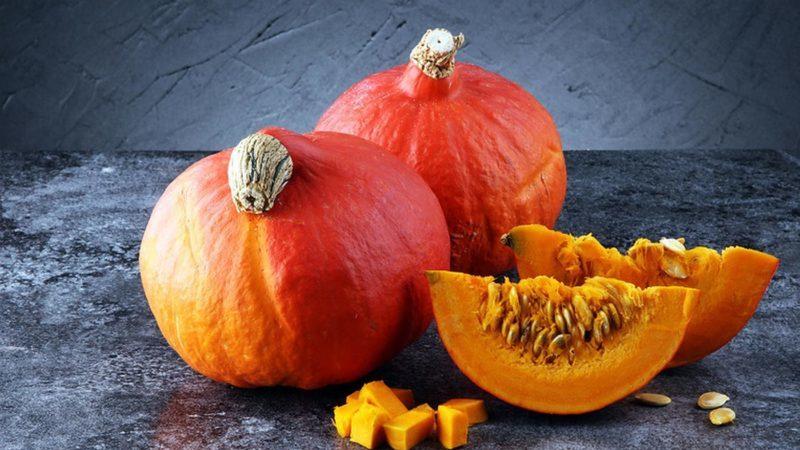
Interesting! In Japan, the name of the Hokkaido variety is Hokkaido pumpkin, in France it is Chestnut pumpkin, and in England the variety is called Winter. In all countries, melons attract the attention of farmers with their interesting appearance.
Distinctive features
The variety also feels great in central Russia, where it is grown in open ground conditions. The bushes are compact, medium in size, and have dark green foliage. Hokkaido is a very unpretentious variety, which is another reason why farmers love it so much. It has strong immunity to weather and disease.
Characteristics of vegetables and yield
Pumpkin weight varies from 1 to 3 kg.The shape varies, from round to pear-shaped. Hokkaido comes in both bright red and gray-green colors. The most common pumpkins are yellow or deep orange. It is noteworthy that green vegetables are in no way inferior in taste to their more “beautiful” counterparts.
The vegetable pulp is tender, with a slight nutty or chestnut flavor. Actively used in preparing many dishes.
The structure is dense, not watery. Depending on the growing region, farmers receive from 10 to 18 kg of ripe vegetables per 1 sq.m.
How to grow
Hokkaido prefers the seedling method. This makes it easier for the vegetable to take root in the ground and show its best side, giving gardeners a rich harvest. However, if you live in the south of the country, where there are fertile soils and a favorable climate, then try planting the crop in open ground.
Planting by seeds
Planting with seeds involves planting directly into the ground, without preparing seedlings. However, this does not mean that the seeds do not need pre-treatment.
For the seedless method to produce results, we recommend:
- Disinfect seed material. Place the seeds on an open porch or windowsill for 5-7 days. During this time, turn them over. This simple method is reliable because the sun's rays not only disinfect the material from dangerous microbes, but also stimulate further development.
- Harden the seeds. To do this, place them in a fabric bag and put them in the freezer overnight. Then remove and leave at room temperature for a day. Then put it back in the freezer, repeating these steps several times in a row.Sudden changes in temperature conditions will help the plant more easily withstand weather changes in the future.
Once the seeds are disinfected and hardened, begin planting. Allocate a bright and spacious place on the site for Hokkaido. It is advisable that legumes or onions grow in these beds earlier. It is recommended to plant pumpkins in late May-early June. The distance between the seeds should be at least 1 m. After sowing, do not forget to water the seedlings with warm water.
Planting seedlings
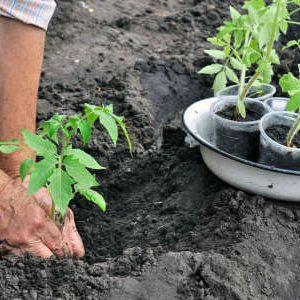 For seedlings you will need prepared soil and a container. You can plant pumpkins both in ordinary flower pots and in special containers.
For seedlings you will need prepared soil and a container. You can plant pumpkins both in ordinary flower pots and in special containers.
Before planting, the container must be disinfected with a solution of potassium permanganate and dried. For seedling soil, use universal compounds, for example “Krepysh” soil. It is already disinfected in advance, so preparing the seedlings will take less time.
It is recommended to grow seedlings in a bright and warm place. If the pumpkin does not have enough light, arrange additional lighting using fluorescent lamps.
It is best to water the seedlings pointwise, trying to avoid moisture getting on the stems and leaves. A week before planting, take the seedlings out onto the balcony for a couple of hours, then increase this time by an hour.
Important! It is best to plant the plant early in the morning on a dry and windless day. Try to ensure that there are lumps of seedling soil left on the sprouts during planting. It is recommended to replant with bare hands so as not to damage the still fragile and weak bushes.
Care
Proper care is the key to a good harvest. First of all, monitor the amount of moisture introduced. Pumpkin has a powerful and developed root system, so do not forget to water it on time.However, there should not be an excess of water, since high humidity leads to various diseases. Especially if the weather outside is hot and dry.
Pumpkins love organic fertilizers. We are talking about manure, compost, humus, humus or chicken droppings. In addition to organic matter, do not forget about mineral supplements. An excellent option would be urea, potassium salt or ammonium nitrate. Also occasionally sprinkle the bushes with wood ash. This universal remedy not only nourishes, but protects against diseases.
Important! It is best to apply fertilizers in 2 stages. The first is when the first 3-4 full leaves appear on the bush. The second stage is the fruiting period.
Also, caring for pumpkins involves timely weeding of the beds and removing weeds. This is especially true after heavy rains. It is recommended to combine weeding with loosening the soil. Loosening removes the hard top crust, which makes it difficult for oxygen to reach the plant. It is better to carry out the procedure every 7-10 days.
Features of cultivation and possible difficulties
Hokkaido must be shaped. When forming into 1 stem, all side shoots are removed immediately after formation. All 3-4 ovaries and a couple of leaves remain on one lash. It is better to pinch the top to slow down the growth of the plant. By forming into 1 stem, you will get more quality vegetables, while they will be small in size.
If you form a vegetable into 2 stems, then there will be fewer pumpkins, but they will be heavier and more massive. To do this, leave only 2 vegetables on the main lash, and 1 on the side. And don’t forget to pinch the tops.
Important! Be careful not to let large pumpkins start to spoil at the bottom.To prevent this from happening, build a small support in the form of bricks or boards.
Growing tips from experienced gardeners
To make Hokkaido tasty and beautiful, gardeners recommend
- Prepare your beds in the fall. Dig up the ground, burn all garbage and old grass. Dig the soil again in the spring.
- Before planting, be sure to treat the soil with a solution of potassium permanganate. It may contain pathogens and other microorganisms.
- During periods of drought, water the pumpkin mainly in the evening with warm water. Do not use cold water from wells; its composition is harmful to the crop.
- Add diluted manure or weed infusion to the water.
- When loosening, the depth should not exceed 12 cm, and 6 cm around the roots.
- Control the number of vegetables on one vine; there should be no more than 8.
- Monitor the amount of mineral supplements; their excess will cause the plant to wither. Write down what and when you fed Hokkaido.
Diseases and pests
The melon aphid is attacking Hokkaido. Although rare, sometimes the insect destroys most of the crop. Aphids look like green bugs that attack pumpkins in colonies.
The affected pumpkin drops its flowers, and the leaves curl and wither. For preventive purposes, spray the crop with 10% karbofos or soap solution. It is better to prevent the appearance of a pest than to fight it later.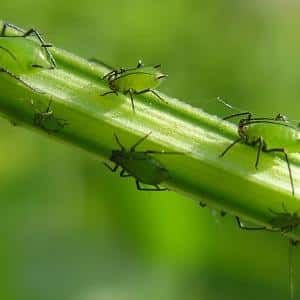
The vegetable is also exposed to the sprout fly. It penetrates the stem, thereby disrupting metabolism. Treating the seeds before planting will help prevent flies from appearing.
Gardeners identify root rot as a disease. From the name it is clear that it affects the roots, as a result of which they acquire a brown tint.Over time, the pumpkin's growth stops and the foliage turns yellow.
The cause of root rot is sudden changes in weather and watering with cold water. The drug “Previkur” helps fight root rot. It is added to water and applied to the beds.
Harvesting and application
Hokkaido ripens well at room temperature, so you can remove the vegetable from the garden at the stage of incomplete maturity. Pumpkins ripen in September. They slowly fill with the desired color, keeping pace with each other. After collection, it is recommended to store Hokkaido in a dry cellar or basement.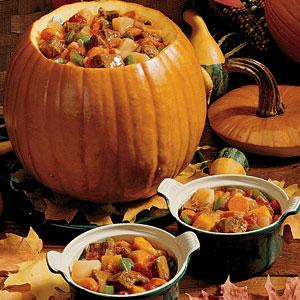
The variety's pulp is dense, so it is used not only for making soups and casseroles, but also as a filling for pies and porridges. Pumpkin is also suitable as a side dish for fatty meat or poultry, as its beneficial properties help avoid heaviness in the stomach and promote faster digestion. The vegetable tolerates freezing well, maintaining its value and taste.
Hokkaido makes excellent puree soup. Both baked and fresh pumpkin are suitable for this. Garlic, ginger, sesame, and cream go well with this dish. Plus, this soup is often served with salmon or shrimp.
Interesting! In Japan, Hokkaido is especially appreciated for its small size. Vegetables are convenient to use as a base for Japanese stuffed dishes. The walls of the pumpkin are no less tasty than its pulp.
Advantages and disadvantages of the variety
Hokkaido is a real treasure for pumpkin lovers. The variety is valued for many reasons:
- Unpretentiousness of culture. Agricultural technology consists of a number of conventional procedures: weeding, watering, loosening the soil and fertilizing. Hokkaido is perfect for those who prefer to spend a minimum of time on care.
- Original taste. Hokkaido is moderately juicy and spicy, with interesting shades of chestnut and nut.
- Versatility in use. Pumpkin goes harmoniously with other vegetables, fruits, meat and seafood.
- Long shelf life. Hokkaido does not lose its value even after freezing, which means that you can enjoy the vegetable for a long time.
- Product benefits. Pumpkin contains a large amount of vitamins, amino acids and macroelements. Moreover, not only the pulp, but also the seeds have beneficial properties.
- Suitable diet food. Particularly popular is the recipe for pumpkin juice, which, in addition to its vitamin value, has a calming effect.
Among the disadvantages, gardeners note the need for formation and the rare impact of insect pests. However, the formation of a bush does not take much time, and to prevent pests, simply carry out preventive measures on time. Hokkaido has many more advantages than disadvantages.
Read also:
Fragrant nutmeg pumpkin variety “Pearl”.
An exotic vegetable with an unusual taste and name - Pink Banana pumpkin.
A tasty and healthy treatment with natural ingredients - pumpkin and honey for the liver.
Farmer reviews
The following reviews can be found on various thematic forums about the Hokkaido variety.
Irina, Stavropol: “Last year I planted the Hokkaido variety for the first time. Orange pumpkins appeared after 87 days. Planted in open ground. As a result, I collected 9 beautiful vegetables from one bush. I froze some and used some for cooking. I’m satisfied with the variety.”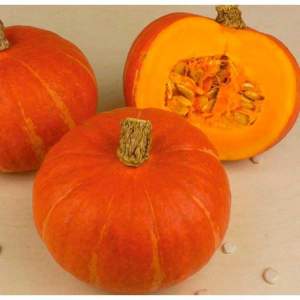
Maria, Tatarstan: “I really love muscat varieties, so I only plant them. Hokkaido is quite good, corresponds to its description.The crop did not suffer from any disease, the harvest ripened on time.”
Olga, Voronezh region: “It formed into one stem, but for some reason many additional shoots and stepchildren were formed later. I didn’t really like this variety; I had to spend a lot of time removing them. The taste was slightly watery, I hoped it would be better.
Conclusion
Hokkaido is a real “star” among gardeners. Not only does it require a minimum of time to care, but the resulting harvest is famous for its excellent taste. Hokkaido has an attractive appearance, good dense texture, and can be stored for a long time.
Grows in greenhouses or outdoors. The vegetable is filled with useful elements and is appreciated by lovers of healthy food. Perfect for meat, sweet pies and ice cream.